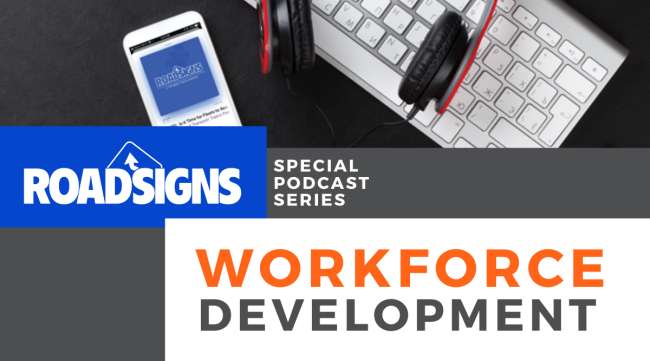Features Editor
Three Concerns for Trucking’s Workforce Development

[Stay on top of transportation news: Get TTNews in your inbox.]
RoadSigns produced a special series of podcasts on workforce development in which Transport Topics explored various ways to obtain and strengthen the talents and attributes of employees.
Please visit https://roadsigns.ttnews.com/ to listen to all four series episodes. Here are some of the issues the leaders of the industry discussed with us:
Be That Image
Ellen Voie, president and CEO of Women in Trucking and also host of the Women in Trucking Show on the Sirius XM Road Dog Channel, said that to encourage more employment of women, the industry must overcome an image problem.

Voie
“When you talk to women outside of the industry and say, have you ever thought about a job in supply chain or transportation, they typically look at you and say, no, they hadn’t,” she said. “So that’s our biggest obstacle is to adjust the image.”
One of things Women in Trucking has done effectively is tell its story to celebrate influential women in the industry.
“We have a distinguished woman in logistics, a female driver of the year … we tell their stories so that other people can see these women in their careers in transportation. [Other women] can think about it and say, ‘You know what, maybe I could do that,’ ” Voie said. “But we also need to reach into earlier ages. We created a Girl Scout transportation patch. We found out the Boy Scouts had one and the Girl Scouts didn’t. So we worked with the Greater Chicago and Northwest Indiana region of Girl Scouts and created the curriculum and a patch.”
Getting New Talent Acclimated

Over the past few episodes, we've had the chance to listen to the experiences of industry leaders and the strategies and planning that go into finding the right people for your workforce. Host Michael Freeze reviews the most important bullet points, from technician and driver training to incorporating diversity in recruitment and retention. Hear a snippet, above, and get the full program by going to RoadSigns.TTNews.com.
Whether they’re from a competing carrier or fresh out of tech school, new technicians have to learn the lay of the land before they ultimately settle in the shop. Ralph Romero, vice president of talent management at U.S. Xpress, says the carrier, along with others, requires its own equipment specifications.
“That’s also going to determine how we’re going to service the equipment, the intervals and the type of techniques that they’re going to use on that particular equipment,” he said. “So while we may be able to pull or attract talent, maybe from other carriers, maybe they spec their equipment a little bit differently. It’s still, there’s probably some gaps that need to be closed by our lead techs.”
As for those directly from tech school, U.S. Xpress assists them through its internship program.
“There are certain things that they work on based off of their curriculum, and there are certain tech schools that we try to partner with to get their talent as aligned as possible with kind of our needs and our equipment needs that does help close that gap a little bit,” Romero said.
Uncertainty Ahead
The pandemic has altered the future, but there are also unknowns in the impact of the delayed Federal Motor Carrier Safety Administration changes that could affect driver training. Compliance date for the new entry-level driver training rule — that will allow drivers between the ages of 18 and 20 to operate commercial motor vehicles in interstate commerce — has been extended until February 2022.

Thropp
“There are going to be changes coming,” said Chris Thropp, CEO of Sage Truck Driving School. “The new entry-level driver training rule … that’s going to be a kind of a game-changer because it’s going to really change the whole paradigm as to how CDL training is done, because schools will have to be approved by FMCSA and beyond the training provider registry. They’re going to have to verify that all the theory training topics and all of the proficiency determinations have been done in terms of skills.”
Thropp believes the new entry-level rules are going to give some uniformity across the country, raise the profile of the industry and hopefully help expand funding for truck driving schools.
“I do think that working in the trucking industry is really a very good job for a lot of people,” he said. “And if we can make that available to more people, I think that would be good for the economy, good for individuals and good for the trucking companies.”
Want more news? Listen to today's daily briefing:
Subscribe: Apple Podcasts | Spotify | Amazon Alexa | Google Assistant | More



